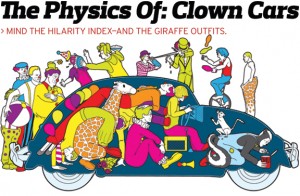The Physics of Clown Cars
My good pal Greg DeSanto (executive director of the International Clown Hall of Fame) is quoted extensively in the April 2011 edition of Car and Driver, talking about the Physics of Clown Cars.
They spend an inordinate amount of time trying to figure out (in mock terms) the maximum amount of clowns that can fit in a car.
Here’s a sample from the article:Â (To read the whole thing, visit the online story listed below)
http://bit.ly/physics_of_clown_cars
Unfortunately, and contrary  to accepted folklore, clowns need to breathe. Discomfort is to be anticipated, but General SurÂvivability demands some consideration of  physiological needs.  Moreover, the overriding concern of anyone packing clowns into a car must be that the result is Maximum Clown Hilarity. Not only must the clown car dispense clowns, it must also disgorge props such as expandable luggage, beach balls, and two-person giraffe outfits with spring-loaded necks. These props cut into the space available for clowns.
How many clowns (X) that can be stuffed into any Clown Car (CC) therefore can be expressed in this simple equation:
 |
However, it’s the mixture of various clown types being shoved into the subject car that results in Maximum Clown Hilarity. Using the Relative Hilarity  Threshold of a six-year-old boy (RHT6) as a denominator, this can all be expressed in this straightforward equation:
 |
Of course, the equation above doesn’t account for the use of  Wacky Props (WP), Improvised Pratfalls (IP), Goofball Mugging (GM), or Generalized Anarchy (GA). Throw those in, and the equation grows in its usefulness, elegance, and mathematical subtlety.
 |
In layperson’s terms, according to DeSanto, all of that boils down to somewhere between 14 and 21 clowns, with their props, in the typical compact clown car.

